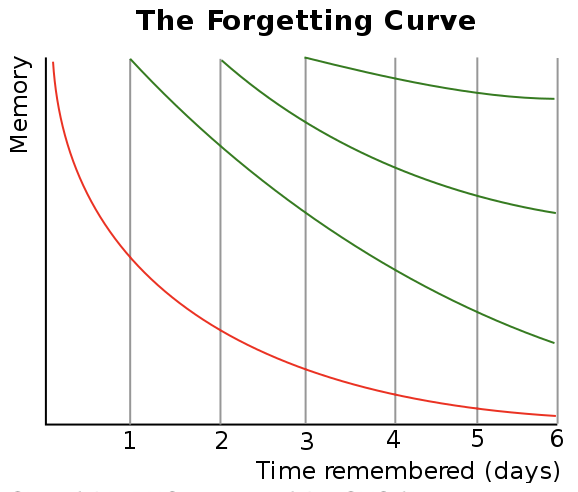Why doesn’t anyone teach us how to study properly for exams?
I know students from my time at university who studied for 10 hours every day and still failed the exam. How is that possible?
What do people do differently to achieve better results in less time?
One thing I can clarify upfront: they’re not necessarily smarter.
They simply have a better study method at their disposal.
In this article, I’ll explain the Active Recall study method, which has been found to be the key to peak academic performance in numerous scientific studies.
Passive vs. Active Learning
When it comes to excelling in exams, it’s not just about the number of hours you spend studying, but rather the effectiveness of your study methods.
In a comprehensive 58-page meta-analysis conducted by Dunlosky et al. in 2013*, examining various learning approaches, the authors revealed that commonly used techniques such as re-reading, highlighting, or summarizing notes often do not yield the desired results.
But why do these methods remain so popular?
The answer is quite simple: they are straightforward and have been the traditional way of studying for a long time.
Reading and highlighting notes are very convenient.
And who hasn’t experienced this: after reading something multiple times, you might even feel well-prepared.
However, a word of caution!
When suddenly asked for specific details, many find themselves at a loss. There’s a difference between merely recognizing information and actually recalling it.

The Study Secret: How Our Brain Functions
To understand the best way to study, let’s take a brief journey into the realm of neuroscience. To make this more relatable, I’ll illustrate it using the example of Belinda.
Picture Belinda as she prepares for her upcoming exam, diligently reviewing her lecture slides repeatedly. At this very moment, various regions of her brain are operating at full capacity.
The occipital lobe is busy creating mental images of what she’s currently perusing, while the angular gyrus and the fusiform cortex are hard at work, deciphering the meanings of the words she’s reading.
Once the information has been processed, the brain dispatches it to the hippocampus – essentially the brain’s memory hub.
But here’s the twist: if you merely read through notes, only a fraction of the information tends to stick. Think of it as you would strengthening your muscles: it requires targeted exercises.
Similarly, your memory – especially the hippocampus – needs the right ‘workout regimen.’
This is where the Active Recall study method comes into play.
While straightforward reading primarily activates the visual aspects of your brain, the hippocampus often gets sidelined.
Hence, passive study techniques like reading scripts or highlighting notes pale in comparison to Active Recall.
What Is the Active Recall Study Method?
Active Recall operates by compelling our brains to actively engage in the study process. Instead of passively absorbing information through reading or listening, Active Recall encourages us – as the name implies – to actively retrieve information from our memory.
The act of actively recalling information trains the hippocampus and increases the likelihood that you’ll remember the information when you need to recall it later (e.g., during an exam).
When employing the Active Recall study method, you can retain what you’ve learned for a significantly extended period and apply it in various contexts.
Let’s explore five ways to incorporate the Active Recall learning method into your exam preparation.
#1 Stop and Recite
Following your reading of a section, momentarily set aside your study materials. Attempt to express the content in your own words.
Afterwards, retrieve the script and compare: What did you manage to remember, and where are the gaps? Fill in those information gaps using the script, and repeat the process until you’ve confidently internalized the content.

#2 Flashcards
Flashcards have been a tried-and-true study method for many students for quite some time. Even the act of creating the cards, where you must articulate information precisely, serves as an effective part of the exam prep.
In today’s digital age, you can leverage tools like Anki to craft flashcards. Anki incorporates another study method that works particularly well for memorization, known as “spaced repetition.” This means that flashcards are revisited at specific intervals.
These intervals are carefully calibrated to enhance your ability to remember the content effectively.
However, a word of caution is in order: when using flashcards for studying, it’s crucial not to overlook active recall.
What do I mean by that? As soon as you can’t explain a term or concept, flipping the flashcard to reveal the answer right away won’t be enough.
This approach does not align with active recall because it doesn’t provide your brain with the opportunity to recall the information from memory. Instead, take a moment to challenge yourself to explain as much of the answer in your own words as possible before checking the back of the flashcard.
Additionally, a small tip regarding flashcards:
They often require you to condense information significantly. This can lead to a situation where you may remember numerous isolated facts but struggle to grasp the broader context or how these facts interconnect.
#3 Create Questions: Your Path to Profound Understanding
Instead of relying solely on your study materials and flashcards, try crafting your own questions related to the content you’re studying.
This strategy encourages you to critically evaluate what you’ve learned and ensures you maintain a firm grasp of the overall context.
Creating questions actively engages your learning process, allowing you to forge stronger connections between the new information and your existing knowledge.
Following each chapter or section, make a note of important questions, and later, challenge yourself to answer them without consulting your notes.

#4 Engage an Audience
A highly effective way to master the material is by teaching it to others.
This process activates various cognitive pathways in your brain. Try explaining the subject of your exam to your classmates, friends, or family members.
Doing so compels you to think deeply about the topic and structure your explanation logically. Furthermore, if you encounter difficulties during your explanation, it serves as an immediate indicator of areas where you need improvement.
Pro tip: In the absence of a live audience, you can even imagine one or engage in a chat with ChatGPT. You can prepare the AI with a prompt to ask you specific questions.
If you’re interested in a dedicated tutorial on using ChatGPT for exam preparation, feel free to leave a comment under this video.
#5 Utilize Past Exams as a Recipe for Success
Reviewing past exams is like a trial run for the real test. You become familiar with the question formats and develop an understanding of what to anticipate in the exam.
When you tackle previous exams under timed conditions, you’ll also hone your time management skills and gauge your level of readiness.
An additional benefit: The more you engage in this practice, the more at ease you’ll feel during the actual exam because you’ll possess insights into what lies ahead.
The Drawbacks of Active Recall
Certainly, Active Recall boasts numerous advantages, but are there any downsides? Undoubtedly!
This method can be rather demanding. It necessitates true engagement and cognitive effort, which is substantially more challenging than simply skimming through your notes or reading the script.
Particularly with complex subjects, it can be frustrating when answers don’t readily come to mind. This study approach requires stepping out of your comfort zone and demonstrating substantial initiative.
Yes, the allure of quickly consulting your notes may be strong, but trust me, the additional effort required by Active Recall is well worth it!
*https://journals.sagepub.com/doi/abs/10.1177/1529100612453266

















